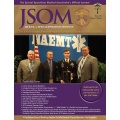Experience With Prehospital Damage Control Capability in Modern Conflict: Results From Surgical Resuscitation Team Use
DuBose JJ, Martens D, Frament C, Haque I, Telian S, Benson PJ 17(4). 68 - 71 (Journal Article)
Background: Early resuscitation and damage control surgery (DCS) are critical components of modern combat casualty care. Early and effective DCS capabilities can be delivered in a variety of settings through the use of a mobile surgical resuscitation team (SRT). Methods: Twelve years of after-action reports from SRTs were reviewed. Demographics, interventions, and outcomes were analyzed. Results: Data from 190 casualties (185 human, five canine) were reviewed. Among human casualties, 12 had no signs of life at intercept and did not survive. Of the remaining 173 human casualties, 96.0% were male and 90.8% sustained penetrating injuries. Interventions by the SRT included intravascular access (50.9%) and advanced airway establishment (29.5%). Resuscitation included whole blood (3.5%), packed red blood cells (20.8%), and thawed plasma (11.0%). Surgery was provided for 63 of the 173 human casualties (36.4%), including damage control laparotomy (23.8%) and arterial injury shunting or repair (19.0%). SRTs were effectively used to augment an existing medical treatment facility (70.5%), to facilitate casualty transport (13.3%), as an independent surgical entity at a forward ground structure (9.2%), and in mobile response directly to the point of injury (6.9%). Overall survival was 97.1%. Conclusion: An SRT provides a unique DCS capability that can be successfully used in a variety of flexible roles.


 Español
Español 




